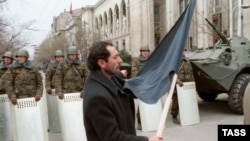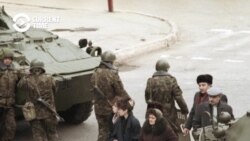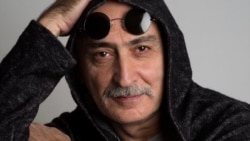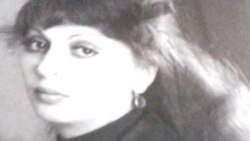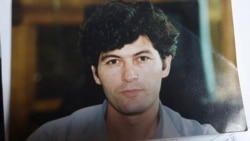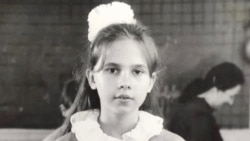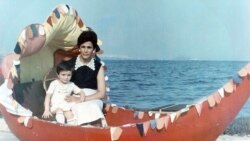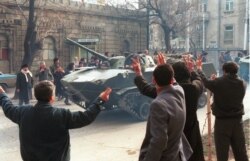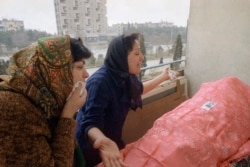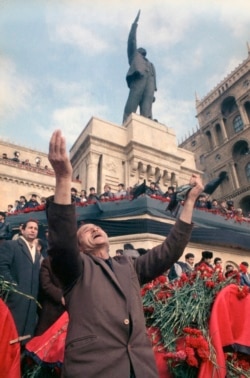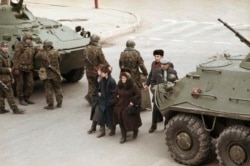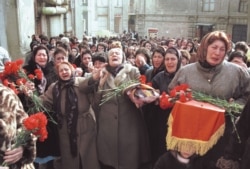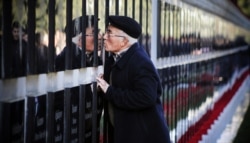Thirty years on, 76-year-old Baku resident Emilie Ragimova still remembers January 20, 1990 in two colors -- red and black.
After a night of indiscriminate violence by Soviet troops that left an estimated 133 people dead and 611 injured, Baku’s sky that morning was “blood-red,” Ragimova said. “And the streets were black: black flags and ribbons everywhere, black clothes on people ... “
There was “an indescribably oppressive atmosphere,” she continued. “A quiet, devastated, crushed city.”
On the night of January 19-20, 1990, the Soviet army rolled into the Azerbaijani capital to try and impose Moscow’s will on a restive population. Soviet Defense Minister Dmitry Yazov said the army was attempting to stop a national protest movement from overthrowing the government.
The army’s actions, though, only reinforced the resolve to break free from Soviet rule.
Yet even today, much remains unclear about what exactly led to the violence and who is to blame for it.
Many of those slain had nothing to do with the anti-government protests that had become part of Baku’s daily life. Among the fatalities were people who assisted the wounded, casual passers-by, and even those who just happened to be near a window at the wrong time.
Current Time has tried to piece together the fragments of this day through the recollections of both protest participants and of those who, until the very last moment, did not understand what was taking place.
Background To Tragedy
In a way, the night of January 19-20, 1990 was the culmination of months of tensions in Baku and throughout Azerbaijan. It occurred against the backdrop of the conflict with neighboring Armenia over the Azerbaijani region of Nagorno-Karabakh, a flood of displaced persons, and growing dissatisfaction with Moscow for not resolving the Karabakh conflict.
The Narodny Front (Popular Front), a national, pro-democratic movement set up in 1988, had become the megaphone for those grievances.
By late 1989, daily rallies of thousands of people, led by the pro-democracy Narodny (Popular) Front movement, were taking place on Baku’s main Lenin Square, and demands for the government’s resignation and for Azerbaijan’s independence from the USSR were sounding louder and louder.
An outbreak of brutal violence against Baku’s ethnic Armenians on January 13 provided an opening “for a showdown between Moscow and the Popular Front,” wrote Carnegie Endowment expert Thomas de Waal in his 2003 book Armenia and Azerbaijan through Peace and War.
A state of emergency was introduced in Nagorno-Karabakh, border areas of Azerbaijan and Armenia, and the Azerbaijani city of Ganja, which had a large ethnic Armenian population.
During this time, a Politburo delegation headed by Yevgeny Primakov, a close ally of Soviet leader Mikhail Gorbachev, and Defense Minister Dmitry Yazov arrived from Moscow to try and stabilize the situation.
Allegations that Narodny Front participants were armed is one of the biggest controversies about the actions of January 20. Defense Minister Yazov declared at the time that there were 40,000 fighters with automatic weapons among them. Witnesses interviewed by Current Time, however, stated that they saw no weapons at the rallies.
Photographer Sanan Aleskerov, then 34, recalled spending almost two days at the Baku rallies before Soviet troops moved in. He maintains that he saw no armed men there.
“It was an amazing time,” Aleskerov said. “I went to the rallies because I believed that this was the beginning of democracy, of a new state. I never loved the USSR and wanted change.”
He remembers a unique “period of unusual solidarity” among Azerbaijanis across generations, gender, and professions.
But his attempts to photograph the rallies failed. Protesters grabbed his camera and smashed it, he said.
“People were afraid because they knew that KGB agents were walking in the crowd under the guise of journalists or simply photographers taking pictures of the rally participants.”
Some Narodny Front members sensed that trouble was coming. For several days, there had been rumors that tanks were going to enter the city. But the activists did not know exactly where the operation would start.
The movement ran cells of supporters in many factories, companies, and educational institutions that enabled them to disseminate information. At the Baku Energy College, Zamina Jabbarova, a 42-year-old professor of Russian language and literature, had set up one of these groups.
“On the afternoon of January 19, the cell’s leadership told me to gather all my students and take them to the Salyan barracks because the troops were expected to be brought into [the city] at night,” Jabbarova said. “But I categorically refused, sent all the students home, and warned the parents over the phone not to let them out.”
That evening, Jabbarova herself went to the barracks, located about 5 kilometers to the northwest of Lenin Square, the main rally site. She recalls seeing “several dozen people” sitting around bonfires there.
One movement leader, Neymat Panakhov, a prominent rally orator, came “and promised that a truck with weapons would arrive soon,” recalled Jabbarova. “He promised that and left. But I didn’t see a single armed man that night.”
One of those sitting around the bonfires, waiting for the tanks, was 22-year-old Shahbaz Huduoglu, today the head of Baku’s Qanun Publishing House. Then a studied in the theater department of Baku’s Institute of Arts, he actively participated in the protests.
“Every day, I went to various events organized by the popular movement, participated in rallies, marches, protests, all kinds of gatherings,” Huduoglu said. “In those days, when people came together and shouted ‘Freedom!’, ‘Independence!’, you felt goosebumps on your skin.”
The Evening Of January 19: A Broken TV
The city’s mood was tense on January 19, recalled Ragimova.
But if some Narodny Front participants had picked up on rumors of plans for an armed crackdown, most other Baku residents did not know what was happening at all.
In hindsight, says economist Tatyana Kovaleva, a broken TV that her father, a radio operator in the Soviet merchant navy, could not fix on the evening of January 19 was a tipoff for what happened in Baku the next day.
“Dad put [the TV] in the middle of the room, took it apart, adjusted it, put it back on, turned it on ... The TV doesn’t work. Again, he dismantled it, adjusted it, assembled it. It doesn’t work. And it was like that several times,” Kovaleva, then a 10-year-old, recalled.
With Soviet repair shops unreliable and her father about to leave on an extended deployment, a heated argument broke out.
“Mom started shouting: ‘See, you can’t fix one thing! You’ll leave now, and we’ll be left without a TV for several months!’ “
Angry, Kovaleva’s father left for the train station, banging the door behind him, and Kovaleva herself ended up gradually screwing the TV back together. “We didn’t know then that Dad wasn’t to blame for the fact that the TV didn’t work,” she said.
That evening, televisions had stopped working throughout Baku. A power unit had been blown up in the city’s TV center. Those responsible were never identified, but analysts generally consider it the work of the Soviet military or special services.
A state of emergency and curfew had been imposed at midnight on January 20, but, without working television sets, few in Baku knew.
The Night Of January 19-20: Tanks Enter The City
Moving from Baku’s northern outskirts, Soviet army troops entered the city from several directions, blocking the bay, just south of the government headquarters, and Baku’s airport. The columns headed mostly into the center, traveling along several avenues, past the Salyan barracks, and near a metro station later named 20 Yanvar (January 20).
Sounds of tank guns firing awoke Ragimova, then a 47-year-old department head at a children’s clinic. She lived with her mother and little daughter close to the site of events.
“They were shooting very close, but the windows of the apartment face the courtyard, rather than the street, so I couldn’t see anything. I only heard the noise of the voices of my neighbors who ran out,” said Ragimova, who still lives in the same apartment. “It was very scary, although I had guessed or felt that something like this would happen.”
For several days before the troops moved into Baku, activists with megaphones had come into the courtyards of city apartment buildings and called for young people to attend the Narodny Front’s rallies, she added.
For the young Kovaleva, who lived in the center of Baku, the sound of shooting sparked no immediate alarm, however. For months, amidst rallies and the recent violence against ethnic Armenians, “something was happening in the city almost every day,” she explained.
“When the shooting started, there was a commotion in the courtyard,” Kovaleva recounted. “All the adults gathered in the apartment of a neighbor who had a radio, and the children, including my brother and I, were ordered to stay home. I was not afraid. Rather, it was somehow surreal.”
Surreal scenes were already playing out near the Salyan barracks. At midnight, flashes illuminated the sky, recalled Jabbarova, who lived near the barracks.
Her son, just out of the army, identified the flashes as tracer bullets. He dressed and left their apartment.
It took Jabbarova “a few more minutes” to realize that her son was now in the street “under these bullets.” She ran out after him.
On the street, “we saw a tank coming toward us,” she continued. “The hatch was open. A strange-looking man with long hair was standing up in it, looking more like a mercenary than an ordinary soldier.”
“I was terrified, wanted to rush at this tank, shouting ‘Killers!’, ‘Fascists!”, but my son pushed me into the side of the road – literally, the bushes -- and literally covered me with his body,” Jabbarova recalled. “And, then, when the danger was over, he took me home.”
Live Bullets And A Blood-Soaked Jacket
At around the same time, Institute of Arts student Shahbaz Huduoglu, still near the Salyan barracks with the Narodny Front activists, remembers seeing a column of tanks moving down Tbilisi Avenue toward the crowd he was in.
“Shots were heard, but people around said that these were not live bullets, that they simply wanted to scare us,” he said. “And we believed that this was the case, that these were not real bullets because, in fact, we weren’t doing anything there. We simply had gathered around the fire, unarmed, intent on not dispersing at any cost.”
But the bullets turned out to be live.
“At first, the tanks fired high, much higher than our heads, and then lower and lower,” Huduoglu said. As the tanks moved closer, the gun barrels moved still lower, putting bullets at the protesters’ level.
Suddenly, one person fell to the ground, he said.
Frightened, those nearby turned and ran up the street, exposing themselves more to gunfire, Huduoglu continued.
“Another person fell, now very close to me. He was injured. Along with someone else, I pulled him aside and threw him over the fence of a nearby hospital,” he said.
As he returned from the hospital grounds, Huduoglu reported, he saw “several tanks already crawling along the central avenues.”
His friends and he spent the rest of the night in side streets.
“I was a step away from death, but I can’t say that I sensed or realized this,” Huduoglu said. “There was no fear. However, there was also no fantastic courage that would make me attack the tanks.”
Nonetheless, in one sense, he already carried the mark of the night’s violence.
A new, foreign-cut white jacket he was wearing had to be thrown away, he recollected. “It was soaked with the blood of that wounded guy.”
“A Planned Provocation”
Proximity to the Ministry of Internal Affairs, in downtown Baku, provided no extra safety that night for 35-year-old Academy of Sciences’ Institute of History employee Leyla Yunus and her family. Machine-gunfire from the street smashed a window in their apartment that faced an internal courtyard.
Yunus’ husband, Arif, headed out to see what was happening and to try and inform international media, the couple wrote in their 2018 book From a Soviet Camp to an Azerbaijani Prison.
“He told [us] how tanks crushed and fired on everything, including the ambulances. They shot at everyone, including children and the elderly. Even people who just went out onto the balcony were shot,” wrote Leyla Yunus, who had left the Popular Front earlier that month.
”Arif said that they even would finish off [some of the wounded].”
Kovaleva shared similar stories.
During the mid-1990s, she went to visit friends living in a part of Baku where the tanks had entered the city. She saw bullet scars there on the outside of residences.
“(My) friends said that two of their neighbors were killed, without even leaving the house,” she said. “They just came to the window and were hit by bullets.”
Red Sky, Black City: The Morning Of January 20
Like Ragimova, Shahbaz Huduoglu and his friends also saw Baku in black that morning. Heading into the city center, they came across several cars crushed by tanks, he said. In Baku’s very center, Fountain Square, still a popular site for evening strolls, the whole square “was already ‘dressed’ in black,” he said.
“On all the trees, people had tied black shawls, ribbons, scarves, as if prepared in advance. And it was as if the city itself -- the trees, the buildings -- sensed what had happened and was filled with sorrow. “
For Zamina Jabbarova, it was the red that stood out.
“On the streets, I saw puddles of blood and carnations laid around them,” she said.
Learning about the many wounded, Jabbarova went to a hospital to donate blood, but was refused. The doctors already had a surplus. “Really, many [people] wanted to help the victims,” she said.
No ready help existed for the anger and fear, however.
En route to work at the children’s clinic that morning, Ragimova and a colleague walked past army tanks on which soldiers, armed with machine guns, were sitting. Her young colleague wanted to scold them, she said, but “I kept her from doing it by force.”
At work, they learned details about what had happened the night before. An admirer of one of the clinic’s nurses and the father of one of its patients were among those killed. The clinic driver “told us how he drove the head doctor to the clinic at night literally under fire, ‘like in a movie,’” Ragimova related.
Photographer Aleskerov had slept through the gunfire the night before.
On the morning of January 20, he went with some friends to the headquarters of the Central Committee of the Azerbaijan Communist Party to see what was happening there.
A tank started driving toward the group, but stopped when the young men, shouting, rushed toward it. Alone, Aleskerov returned home through empty streets.
Not far from his apartment building, he encountered a tank coming around the corner.
“And that’s when I did get scared. Never in my life have I been so afraid as then,” he said. “When there are several of you, nothing is scary – neither rushing toward the tank, nor even dying. But when you are alone, and the barrel is looking straight at you ... “
“I ran into the nearest courtyard I could find, flew up to the very last floor, and waited there until the tank left. “
After January 20: A Park That Became A Cemetery
On January 22, Baku’s TV broadcasts returned with coverage of a mass funeral for those killed. They were buried in one of Baku’s main squares, Lenin Square, now called Azadlig (Freedom) Square.
A huge crowd of mourners went through the city center to a park overlooking the city and Caspian Sea. It became the Alley of Martyrs, or “Shahids,” a name for those who have been killed in battle or fighting for freedom.
“There were really many people, everyone in black. A very depressing picture, even when you see it on TV,” elaborated Ragimova.
In the background, loud speakers played the song Ayriliq (Separation), a 1950s tune that had become “an unofficial anthem of the popular movement,” she recalled.
Despite the song’s beauty, Ragimova still associates it with the funeral – “just like carnations, which I’ve disliked ever since.”
Photographer Aleskerov could not bring himself to photograph the funeral. Instead, he photographed the 40th day after the burials, when, in keeping with Islamic practice, Azerbaijanis gathered again in the Alley of Martyrs to remember the dead. They are the only photos he still retains.
Many remember city-wide mourning throughout those 40 days: Men did not shave, and Baku residents remembered the dead in the courtyards of apartment buildings.
For Huduoglu, the violence of the night of January 19-20 did not lead to depression or shock. But it proved a breaking point in how he and his contemporaries related to the Soviet state.
“Then, we realized that there was no army that would protect us. There was an army that was ready to destroy us. The army in which we used to serve suddenly turned against us. And it was already impossible to believe in such an army.”
Or in the government it defended.
Noted Yunus, now a human-rights advocate in The Netherlands: “We have to remember that the Baku massacre on January 20 was the bloodiest, but not the only case of suppression of a popular movement in the Soviet republics in those years.”
Protesters had been gunned down in Tbilisi, Georgia in April 1989; the same would occur in Vilnius, Lithuania in January 1991.
In Azerbaijan’s case, the Soviet prosecutor's office found nothing criminal in the army’s actions and closed its investigation into the events of January 19-20, 1990.
After independence in 1991, the Azerbaijani prosecutor's office reopened the case a few years later. In 1994, under then President Heydar Aliyev, it brought criminal charges against former Soviet President Mikhail Gorbachev, Supreme Council Chairman Yevgeny Primakov, Defense Minister Dmitry Yazov, and KGB Chairman Vladimir Kryuchkov.
Two officials from Soviet-era Azerbaijan were also charged: Ayaz Mutalibov, Azerbaijan’s first post-Soviet president, who served as chairman of Azerbaijan’s Council of Ministers during the 1990 crackdown, and First Secretary of the Central Committee of the Communist Party of Azerbaijan Abdul-Rakhman Vezirov.
But these charges remained on paper. To date, no one has been held accountable for the events of January 20, 1990.




